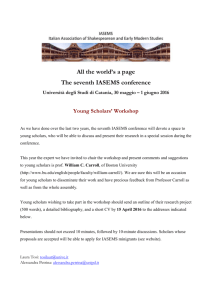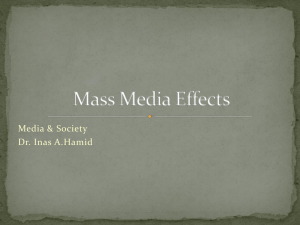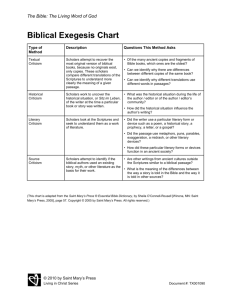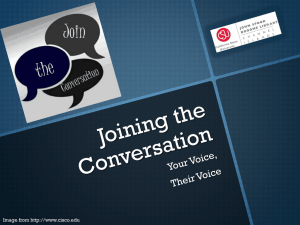c/55-11
advertisement
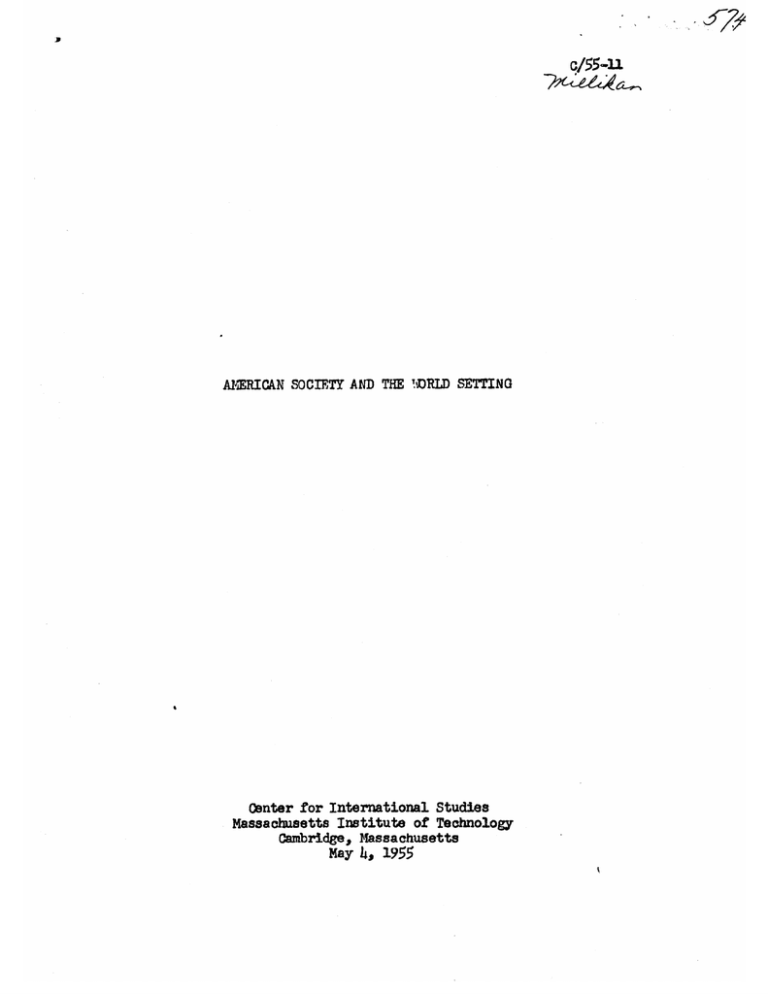
4 c/55-11 AFERICAN SOCIETY AND THE NORLD SETTING Center for International Studies Massachusetts Institute of Technology Cambridge, Massachusetts May 4., 1955 ANERICAN SOCIETY AND THE 'LORLD SETTING The Problem The Center for International Studies has concluded, from four years work on current U. S. relations with the rest of the world, that it is time for a new appraisal of what we know about our own society and where it is going. Why is this needed? The United States is probably the most studied country in the world. In no other country has the economy been more thoroughly graphed; our political processes have been described in minute detail; many monographs have been written on our social structure, our judicial process, our patterns of values, our psychological reactions. Our history and our relations with the rest of the world are the subject of a rich literature, Many compe- tent and some inspired novelists have sought to evoke how various kinds of Americans live and think and feel. Yet we are seriously misunderstood abroad. What is perhaps even more disturbing is that we do not understand ourselves. The pace of events has been so rapid in the last decade and our role in' the world has changed so radically that 'as a people we have not had time to sort out what was happening to us, to relate each of our new problems,--atomic energy, Communism, our world economic position, our large peace-time military establishment, our responsibilities 2 as an occupying power in foreign areas, and the like,-to our historic American purposes and ideals. This gap in our self-understanding is reflected in uncertainties in the design of programs of American studies at our colleges and universities. Where these programs are focussed on American political and economic history they rely largely on books that cannot relate our present to our past because they were written before World War II. 'Wbere they attempt a picture of contemporary American society they are forced to pick selectively from a shelf of specialized research reports of varying deptn and quality or to give undue prominence to the particular insights of a comentator with an axe to grind. Since we have become confused about ourselves, our own strengths and weaknesses, our continuity with our own past, and our appropriate future role, it is not surprising that our friends in the rest of the world should be confused as well. The Great American Dream, which we and they thought we understood fifty years ago, has become obscured to the point where many abroad believe we have abandoned it altogether. At home we have developed some of the surface signs of anxiety and neurosis that the psychologists tell us are characteristic of a personality that has ceased to understand itself and that confronts unfamiliar decisions. We are concerned about (and perhaps exaggerate) our vulnerability to a host of menacing threats. In other directions we fail to recognise some of the things that might very well happen to us. There is no lack of will to tackle the problems that face us. 3 Our great asset continues to be a reservoir of intellectual and moral energy that suffers only from a lack of direction. The findings of individual research studies on one or another aspect of American life give us separately little sense of direction because there is available no picture of the shape of the organism as a whole in terms of which to give these findings a new context. This is partly a consequence of the compartmentation of American scholarship. . Each of the social science disciplines has selected a few aspects of American society on which to practice using its own special tools. We have been growing so rapidly and our role in the world has changed so suddenly that few thoughtful and balanced synthesizers have emerged to reinterpret where we are. If as citizens we retained a strong sense of the unity of our culture, it would matter less that as scholars we were not bold enough to attempt to outline it as a whole. With the people somewhat confused about them- selves, an effort by scholars to review where we stand and to clarify the big issues may be worth the intellectual risk of inadequate precision and depth. The Center is inclined to think that in spite of the surface signs of confusion, American society today is more coherent, more purposeful, and possesses more continuity with its traditions than is generally realized. We believe expression can be given to this coherence through a project under the guidance of one man but drawing upon the knowledge and judgment of a wide range of scholars. If we are right, the problem of America is more one of knowing itself than of changing itself. But as with the individual personality, tho nation will act more wisely and vigorously, and project a truer Lbage of its purposes to the rest of the world if it understands itoseli better. The purpose of the proposed project is twofold. First we hope to contribute to this self-understanding, to portray for Americ rs and for our friends abroad the essential characteristics of contenporary American society, and to interpret the way in which that sod.ety has reacted to the pressures, dangers, and responsibilities t ha, faced in its relations to the rest of the world since the ent of World War II. If we are at all successful in achieving this purpots, we can hope to serve indirectly the further purpose of improving Ame.-can performance in the world in ways which will strengthen rather "an weaken the ultimate values of American society. Second, we hope, by a systematic review of research and toehing materials on American society, to suggest some directions futuri research should take in order to fill ;aps in our self-knowledge, and to explore the appropriate content for American studies programs U. S. colleges. . We intend, well along in the course of the work, call a conference of interested persons on this last topic. ThePoosal We propose that the Center for International Studies undertake to organize a three-year project on American Society and the World Setting. The project as now tentatively envisaged would have four kinds of related products: 5 1. A book on the project's central theme. This, being a synthesis aiming at a coherent intellectual structure, would be by a single author, the project director, with such research assistance as he needs. It would require for its preparation, and would draw heavily from, the other products. 2* A series of essays, monographs, and perhaps volumes by a variety of scholars with special competence in parti. cular fields of research on America. These would appraise the state of the literature and of ongoing research in their field, develop judgments on specific aspects of contemporary American society requiring treatment not to be found in the existing literature or focus the special knowledge and talent of the authors on questions important to the thesis of the central volume. 3. A series of criticisms and discussions of drafts of the central volume and the supporting studies by scholars and other knowledgeable observers* To some extent these comments and criticisms would be reflected in the final draft of the volume, but many would be separately published. To the extent that points of view emerge from the criticism which are not reconcilable with that of the principal author they might provide the material for a published volume of commentary. 4. A conference on the purposes, present content, and possible future direction of Aerican studies programs at 6 U. S. colleges and universities. M.I.T. in particular hopes to derive from this project a clearer and more imaginative concept of what its American Industrial Society program should try to accomplish and how it should go about it. We hope the conference will stimulate other institutions to a similar reappraisal. Intellectual Content ard Procedure Detailed ideas about what these four products would contain must remain, of course, highly tentative until the project is further along. The character of contemporary America is a result of the interaction of its inherited characteristics and the environment in which it finds itself. The synthetic volume may provisionally be thought of as a marriage of two lines of thought, concerned with the influence of these two factors. America in the decade following World War II has behaved as it has partly because of its own history. The fabric of its society is thus to be explained partly by what it brought with it out of its own past. On the other hand it has, of course, been sharply influenced by the impact of events in the world around it over the decade. An essential part of its developing personality must be traced to the ways in which and the places in which these events have impinged upon it, and the forms of its response to them. Tentatively, we see the project as involving three stages, each of which might take roughly a year's work, though it might prove desirable to extend this period somewhat. 7 In Stage One a small group, neaded by the project director, would set to work simultaneously on both the above lines of thought. General and partial theories and concepts of America's historic evolution would be systematically reviewed, including those relating to the development of U. S. foreign policy. This review would embrace the work of philosophers, poets, historians, economists, engineers, and natural and behavioral scientists of various kinds; and it would include foreign as well as American commentators. The evolution of American society, notably over the century of its industrialization, would be compared with others to assist in identifying its unique characteristics, with special emphasis on those bearing on its relations with the external world. Over the course of the year this effort should yield initial basic hypotheses for the writing of part of the central volume. At the same time a list would be drawn up embracing the specific forms which the impact of our foreign position has assumed in recent years; for example, the scale of the military establishment, the functions of the Foreign Service, civil-military responsibility in policy formation, the enlarged scale of government outlays, Executive Branch-Congressional relations, the interaction between civil liberties and the Communist threat, grass roots responses to our foreign involvements, etc. out: For each item on the list two procedures would be carried first, the material already available for an assessment of the form and extent of impact and response would be examined for its 8 adequacy; second, the importance of the form of impact and its relation to the over-all position U. S. society had reached at mid-century would be considered. It is evident that, intellectually, the two exercises--one general and synthetic, the other' particular and cross-sectionalshould be carried on by the same small group, simultaneously; for the general shape of the central %olume and its content must arise from the interplay of the two perspectives and from their ultimate unification. As the preliminary assessment p:aoceeds various needs for special studies will emerge. First, there may lI cases where a considerable body of relevant material on a crucial tcoic may have been published but the project staff may lack the expertieo to review it it effectively to bear on a central issue. and to bring Second, there may be gaps in the available published information and aralyses which could be filled by the writing of an essay by an acknow. edged authority in a special field. Third, a scholar may have assemIled a good deal of relevant but unpublisned data which he could effEOtively focus in a brief period on a particular set of questions. Fo-rth, there may be some fresh analysis which is required to answer a qustion arising out of the central volume and which it appears feasible t, coinplete within the limits of time and money set by the scope of the p.oject. The initial review will almost certainly reveal major gaps ii our selfknowledge which could be filled only by applying substant-al research resources to them. There will, of course, be many questionL a project 9 of this size and duration could not hope to answer. Care will be taken not to undertake research which cannot be expected to yield useful results within the projected time scale. Where problems requiring long-term research are exposed by the project an attempt will be made to define them and suggest how they might be tackled by other researchers. These specialied essays and monographs may take a variety of forms. Some may be social science analyses of quantitative data. An example might be a semi-statistical picture of the attitudes of the business community to foreign economic relations such as could be derived from a large sample of interviews on this topic recently completed by the Centerts Communications Program. Another might be a general review'of what we have learned to date about American attitudes toward foreign affairs from the many opinion surveys that have been conducted by various organizations, and the limitations of this knowledge. Another form might be a broader analysis of the U. S. scene by an imaginative observer such as David Riesman. It would probably be desirable to associate with the central team a young foreigner who might do a monograph of his own in Stage Two. Consideration might even be given to commissioning a perceptive novelist like John Hersey or James Gould Cozzens to try to capture in fictional form the impact of our foreign position on various kinds of Americans. specific list The of tasks to be performed can be constructed only after the project director has been at work long enough to have formulated 10 his tentative hypotheses and become familiar with what is already available that bears on them. An important purpose of these special studies, in addition to supporting the work of the project director, would be to arrive at an appraisal of the coverage, quality, and balance of work done to date in various fields. In Stage Two the writing of drafts of both the central volume and the special studies would proceed. An initial version of the central volume would be produced, and by the end of the Second Stage it would be widely circulated for detailed criticism mainly among scholars. - The bulk of the special essays and studies would also be completed in draft during this stage, though some of the studies might take somewhat longer. In Stage Three, criticisms of the central volume and the special studies would be absorbed by the various authors; the results arrived at by the various authors would be taken into account in new drafts; and the second draft of the central volume would be circulated widely for criticism and for the formulation of alternative views of the central issue. A draft of the central volume of the project might well provide a starting point for the conference* It could then proceed to an outline of the fields which American studies programs should cover and the materials presently available for use in each. The biblio.- graphy and special studies of the project would constitute much of the background material for this part of the conference, though some. papers focussing on limitations on the use of existing materials for 3 teaching might be called for. For those sessions of the conference focussed more directly on specific curricula, course organisation, the content of undergraduate and graduate study, and the like, materials would presumably have to be largely prepared specially for conference use. Our present thinking is that the conference would extend over a number of days, that it would be relatively small (not more than forty or fifty people at the outside) and that it would be attended primarily by those responsible for and participating in American studies programs in principal U. S. institutions. At the conference, as in the project, a special effort would be made to focus attention on materials and topics which have not conventionally been covered in programs of this sort. It is our impression for instance that the contributions of social science to an understanding of American civilization have received less attention than those of political history on the one hand and literature and the arts on the other. It is also our impression that technological influences on American industrial society have been inadequately treated both in the literature and in course programs. Administrative Procedure The task envisaged for the project requires that one man assume intellectual and administrative responsibilty; but that he be able to call upon the talents of a wide variety of experts, that te be 12 subjected to the widest possible range of intellectual advice, stimulus, and criticism, and that the project be so organized as to minimize the amount of iis time and energy absorbed in administration. It is, therefore, suggested that, from ain earl, point in Stage One, an Advisory Board be created. It should embrace several first- rate mature men drawn from history and the social sciences, a leading natural scientist, and one or two outstanding citizens with foreign policy experience and a serious interest in the problem and the project. They would be consulted at various stages in a way suffi- ciently informal to permit a free exchange of views on key decisions, reading and criticism of early drafts, etc. They might be consulted individually as well as in formal session, depending on the questions involved. They would also participate in the design and planning of the conference. For the First Stage the central team would consist of three or four persons, including the project director, plus secretaries and a bibliographical assistant. Not all of this team need be full time; but at least half of their time should be given over to the project. In Stage Two several of the initial central team might take on monographic studies of their own; the director would write the central draft, with perhaps one person to assist in administrative detail and another to assemble materials, etc. The number and character of special stidies and monographs cannot now be predicted; but it is clear that a very substantial proportion of the total project funds should be allocated for this Second Stage purpose. 33 The planning and administration of the conference would be handled by the staff of the Center for International Studies in close cooperation with the Department of Humanities of the Institute and faculty members in other departments (e.g., City Planning, Economics, Industrial Administration) whose teaching and research programs relate to this general field. It is planned to consult directors of American studies programs at a variety of institutions well in advance of the crystallization of conference plans. Facilities and Experience of M.I.T. The Center for International Studies has completed two studies of foreign societies which, while of more limited scale, were designed along much the same lines as the above proposal. One on the Soviet Union was completed in the summer of 1952 and the other on Communist China was completed in August 1954. Both were under the direction of Professor Walt Rostow, whom the Center proposes to put in charge of the present study if it is approved. The problem posed by this project has been a continuing preoccupation with Professor Rostow for a good many years. It was essentially the subject of his inaugural lecture at Oxford when he held the Harmsworth Professorship of American History there during the academic year 1946-1947. Again in 1949-1950, he was the Pitt Professor of U. S. History at Cambridge University. While his most important professional publications in the historical field relate to the British econormy, he has always had a very great professional interest in American history, and it was his central task for the two years during which he was on the faculties at Oxfori and Cambridge to interpret America to British students. More recently, Professor Rostow has concerned himsel at length with the problem of the relationship between economic change in developing societies and the entire pattern of political, ciltural, ethical, and other variables which interact with economwic chtnge. His principal publication in this field is the Process -f Economic Growth* Another facet of his interest in the analysis of societies in motion is reflected in the two projects he has completed ior the Center. It is perhaps also wortn noting that his central :'ocus in undertaking the two studies of foreign societies which he h's done in the last three years was to relate the pattern of develo;ents in these societies to U. S. policy and the U. S. national intirest. In both of these Professor Rostow undertook extensive suiTeys of the available literature, commissioned special studies and monographs to fill gaps in knowledge or understanding, and draf ed a central synthetic volume. In each case this volume was subjeczed to detailed criticism by a large number of senior scholars in tha field representing all possible points of view. In each case the drafts were thoroughly rewritten in the light of these comments,, The product, in addition to a shelf of monographs, was in one case The Iynamics of Soviet Society (Norton, New York, 1953, $3.95; also New American Library, New York, 1954, 50 cents) and in the other 25 case The Prospects for Comunist China (WlNey, New York, 1954, $5). While these two projects took him away from his central professional focus on the United States his willingness to undertake them arose in considerable part from his conviction that America since l941 has been profoundly shaped and influenced by the impact on it of developments elsewhere in the world. Certain developments in its educational program heighten the interest and perhaps the capability of the Institute to carry out both the project and the conference. A new program of undergraduate study has just been inaugurated at the Institute desined to provide a general education for students with scientific or engineering aptim tudes, based on the possibility of a terminal degree in four years which will provide, we believe, a good training for general work in modern society, with the opportunity in an additional year to take a second degree providing professional competence in a specific field of science or engineering. For such students the program offers course work in scientific and engineering subjects which will occupy about half the students' time, the other half being devoted to one of a series of options in the humanities and social sciences. At the end of the four-year period when he receives his B.S. the student in this program will not have the full qualifications of an undergraduate degree in engineering or science but will have a muon broader base in non-s'cientific fields than nas been possible at the Institute before. The program is so arranged that with an additional fiftn year of work 16 he can -acquire professional competence and a degree in a specific field of science or engineering if he so desires. One of the options in this program is an option in American industrial society. The staff of the Department of Humanities at the Institute is trying imaginatively to develop a program in this option which will give more weight to the industrial and technological component in American civilization than is customarily done in American studies courses but which will at the same time pay full attention to the humanistic side of American life. The director of this program regards the conference proposed in this submission as an opportunity to test some of the ideas being developed under this concept against a variety of other conceptions of how to approach an understanding of American civilization. A grant, if made, would be made to and administered by the Massachusetts Institute of Technology. The project would be adminis- tered directly by the Center, which currently is administering research studies in France, Italy, India, Burma, and Indonesia in addition to the United States.

